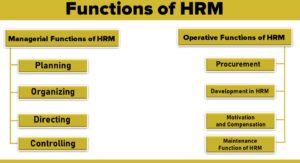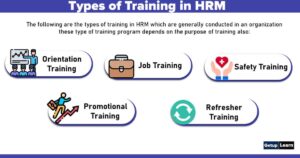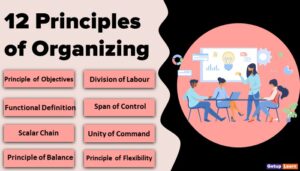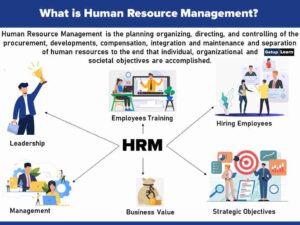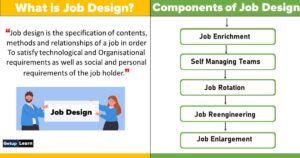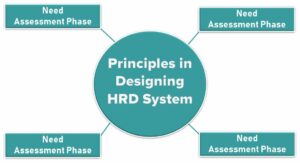Table of Contents
- 1 What is Transfer?
- 2 Definition of Transfer in HRM
-
3 Purposes of Transfer of Employees
- 3.1 To Meet the Organizational Requirements
- 3.2 To Meet Employees’ Requests
- 3.3 To Ensure Better Utilization of the Employees
- 3.4 To Make the Employees More Versatile
- 3.5 To Adjust the Workforce
- 3.6 To Provide Relief to the Employee
- 3.7 To Reduce Conflicts and Incompatibilities
- 3.8 To Penalise the Employees
- 3.9 To Maintain a Tenure System
- 3.10 To Accommodate Family-Related Issues
- 4 Types of Transfer in HRM
- 5 Causes of Transfer in HRM
- 6 Transfer Policy
- 7 Difference Between Transfer and Promotion
- 8 FAQ Related to Transfer in HRM
What is Transfer?
A transfer is a change in job assignment. It is the internal movement of an employee from one section to another without involving any substantial change in his duties, responsibilities, required skill, status, and compensation. A transfer does not imply any ascending (promotion) or descending (demotion) change in status or responsibility.

Transfer means shifting of an employee from one job to another, one unit to another, or one shift to another and may involve a new geographical location. Transfers have a number of objectives, such as moving employees to positions with a higher priority in terms of goals, placing employees in positions more appropriate to their interests or abilities, or filing department vacancies with employees from overstaffed departments.
Definition of Transfer in HRM
These are definitions of transfer in hrm given below:
[su_quote cite=”Edwin B. Flippo”]Transfer is a change in job where the new job is substantially equal to the old in terms of pay, status, and responsibilities.[/su_quote]
[su_quote cite=”Dale Yoder”]A transfer involves the shifting of an employee from one job to another without special reference to changing responsibility or compensation. The transfer may involve promotion, demotion, or no change in status and responsibility.[/su_quote]
Thus, the transfer is a horizontal or lateral movement of an employee from one job, section, department, shift, plant, or position to another at the same or another place, where his salary, status, and responsibility are the same.
Purposes of Transfer of Employees
These are the purposes of transfer of employees in HRM:
- To Meet the Organizational Requirements
- To Meet Employees’ Requests
- To Ensure Better Utilization of the Employees
- To Make the Employees More Versatile
- To Adjust the Workforce
- To Provide Relief to the Employee
- To Reduce Conflicts and Incompatibilities
- To Penalise the Employees
- To Maintain a Tenure System
- To Accommodate Family-Related Issues

To Meet the Organizational Requirements
Organizational changes may demand the shift in job assignments with a view to place the right man on the right job, Such changes may be changes in technology, changes in the volume of production, product line, production schedule quality of products, change in the job pattern, fluctuations in the market conditions, reallocation of or reduction in the workforce due to a shortage or a surplus in the same section so that layoffs may be avoided, filling in of the vacancies which may occur because of separations or because of the need for suitable adjustments in business operations.
In short, the purpose of transfers is to stabilize employment in an organization.
To Meet Employees’ Requests
Sometimes, the transfer is done at the request of the employer himself. Employees may need a transfer in order to satisfy their desire to work under a different superior in a department/region where opportunities for advancement are bright, in or near their native place or place of interest, doing a job where the work itself is challenging, etc.
To Ensure Better Utilization of the Employees
An employee may be transferred because the management feels that he is not performing satisfactorily and adequately and when the management feels that he may be more useful or suitable elsewhere, where his capacities would be better utilized.
To Make the Employees More Versatile
Employees may be shifted from one job to another to expand their capabilities. Job rotation may prepare the employee for more challenging assignments in the future.
To Adjust the Workforce
The workforce may be transferred from a plant where there is less work to a plant where there is more work. Thus, the employees who have been in service of an organization are not thrown out of employment but adjusted elsewhere.
To Provide Relief to the Employee
Transfers may be made to give relief to employees who are overburdened or doing hazardous jobs for long periods. The transfer may also be made to break the monopoly of the employee. The climate of a place may be unsatisfactory for an employee’s health. He may request a transfer to another place, where his health may not be affected by the climate.
To Reduce Conflicts and Incompatibilities
Where employees find it difficult to get along with colleagues in a particular section or department, they could be shifted to another place to reduce conflicts.
To Penalise the Employees
Transfers may be effected as disciplinary measures to shift employees indulging in undesirable activities to remote, far-flung areas.
To Maintain a Tenure System
In senior administrative services of the Government and also in industries or where there is a system of the annual intake of management trainees, the employee holds a certain job for a fixed tenure but is made to move from job to job with a view to enable him to acquire a variety of experience and skills and also to ensure that he does not get involved in politicizing informal groups.
Family-related issues cause transfers, especially among female employees. When they get married, the female employees want to join their husbands and this fact necessitates transfers or resignations.
Types of Transfer in HRM
Let’s discussed the types of transfer in HRM:
- Production Transfers
- Replacement Transfers
- Versatility Transfers
- Shift Transfers
- Remedial Transfers
- Precautionary Transfers
- Sectional Transfers
- Departmental Transfers
- Inter-Plant Transfers
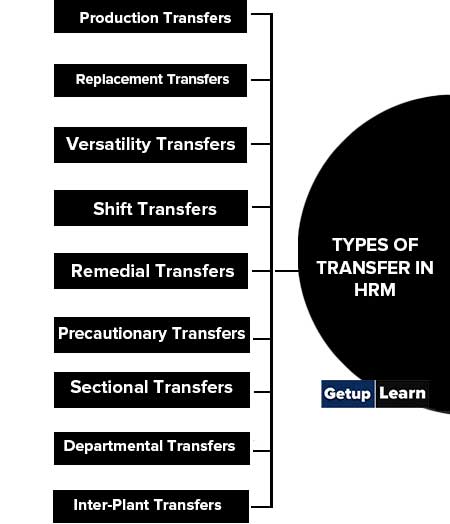
On the Basis of Purpose
Production Transfers
A shortage or surplus of the workforce is common in different departments in a plant or several plants in an organization. Surplus employees in a department have to be laid off unless they are transferred to another department. Transfers affected to avoid such inevitable layoffs are called production transfers.
Replacement Transfers
A replacement transfer is the transfer of a senior employee to replace the junior employee or a new employee, when the latter is laid off or shifted to another job, Sometimes, it is a temporary arrangement to make use of the services of the senior personnel.
Versatility Transfers
Versatility transfers are effected to make employees versatile and competent in more than one skill. It aims at giving training to the employees of various jobs of similar nature having different operations. It helps the employees to get themselves prepared for promotions and also helps the employer in developing the effective manpower prepared to handle the higher openings.
Shift Transfers
When the unit runs in shifts, employees are transferred from one shift to another on similar jobs. In some undertakings, where shifts are operated regularly, employees may be recruited permanently for the shift, but in some cases, they are rotated from one shift to another as a matter of practice because many employees dislike second or third shift assignment as it interferes with their social or family engagements.
Remedial Transfers
Remedial transfers are effected at the request of the employees and are, therefore, called personal transfers. Personal transfers take place because the initial placement of an employee may have been faulty or the worker may not get along with his supervisor or with other workers in the department.
He may be getting too old to continue his regular job or working conditions may not be well adapted to his personal health. If the job is repetitive, the employee may stagnate and would benefit by transferring to a different kind of work.
Precautionary Transfers
Such transfers are made as a precautionary measure to avoid the misuse of office or misappropriation of funds by the employees. In some undertakings, there are more chances of misuse of office or misappropriation of funds than in others. Generally, it is mentioned in the transfer policy of the organization that an employee cannot stay at one post for more than 3 years or so.
On the Basis of Unit
Sectional Transfers
These transfers are made within the department from one section to another. The main purpose of such transfers may be to train the workers and prepare them to handle the operations of different sections of the department.
Departmental Transfers
Transfers from one department to another department within the plant is called departmental transfer. Such transfers are made if the nature of work is the same or substantially the same in both the departments such as clerical or routine jobs.
Inter-Plant Transfers
If there is more than one plant under the control of the same management, the transfer may be made from one plant to another for varied reasons. Such transfers are called inter-plant transfers.
Causes of Transfer in HRM
In modern organizations, these are the causes of transfer in hrm:
- Meeting Organizational Needs
- Meeting Employee’s Requests
- Better Utilization of the Employees
- Developing All-Rounder
- Manpower Adjustment
- Avoidance of Conflicts
- Punishing the Employees
- Relief to Employees
- Tenure System
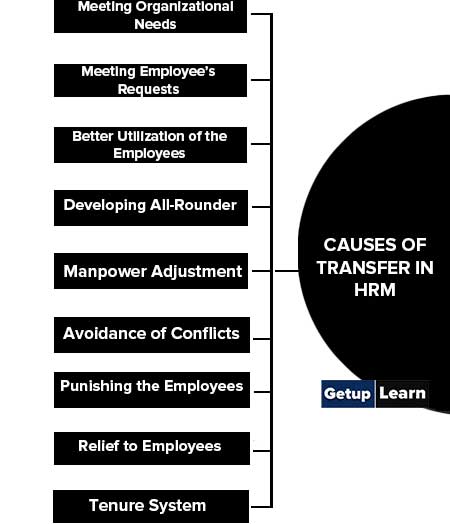
Meeting Organizational Needs
A company may transfer employees due to changes in the volume of production, technology, production schedule, product line in organization structure, market conditions, etc. filling in the vacancies which may occur because of separations or because of the need for suitable adjustment in business operations. In short, the purpose of the transfer is to stabilize employment in the organization.
Meeting Employee’s Requests
Transfers are also done at the request of the employees. Employees may need transfers in order to satisfy their desire to work under a different superior in a department/region where opportunities for advancement are bright, in or near their native place, doing a job where the work itself is challenging, etc. Many employees seek transfer because of family-related issues such as marriage or illness.
Better Utilization of the Employees
An employee may be transferred because the management feels that he is not performing satisfactorily and adequately and when the management feels that he may be more useful or suitable elsewhere, where his capacities would be better utilized.
Developing All-Rounder
The employees may be transferred to different jobs to widen their knowledge and skills. In some companies, transfers are made as a matter of policy after an employee has stayed on a job for a specified period. Such rotation from one job to another serves as a tool for developing versatile workers.
Manpower Adjustment
The employees may be transferred from a plant where there is less work to a plant where there is more work. Thus, the employees who have been in service of an organization are not thrown out of employment but adjusted elsewhere.
Avoidance of Conflicts
Where employees find it difficult to get along with colleagues in a particular section or department, they could be shifted to another place to reduce conflict.
Punishing the Employees
Transfers may be made as a disciplinary measure. The employees indulging in undesirable activities may be transferred to remote, far-flung areas or transferred to less important jobs.
Relief to Employees
Transfers may be made to give relief to employees who are overburdened or doing hazardous jobs for long periods. The transfer may also be made to break the monopoly of the employee. The climate of a place may be unsuitable for an employee’s health. He may request a transfer to another place, on health grounds.
Tenure System
In senior administrative services of the Government and also in industries, the employees hold certain jobs for a fixed tenure. They are made to move from job to job with a view to acquire a variety of experience and skills and also to ensure
Transfer Policy
A sound, just and impartial transfer policy should be evolved in the organization to govern all types of transfers. This policy should be clearly specified so that the superiors cannot transfer their subordinates arbitrarily and the subordinates may not request transfers even for petty issues.
The management must frame a policy on transfers and apply it to all the transfers instead of treating each case on its merit. Such a policy must be based on the following principles:
- Transfer policy must be in writing and be made known to all the employees of the organization.
- The policy must very clearly specify the type and the circumstances under which company-initiated transfers will be made.
- The basis for transfer should be clearly mentioned in the policy. Whether it will be based on seniority or on skill and competence or any other factor.
- It should indicate the executive who will be responsible for initiating and approving the transfers.
- The policy should specify the region or unit of the organization within which transfers will be administered.
- The effect of the transfer on the pay and seniority of the transferred employee may be clearly evaluated.
- It should be prescribed in the policy whether training or retraining is required for the new job.
- Transfers should be clearly defined as temporary or permanent.
- The interests of the organization are not to be forgotten in framing a policy of transfer.
- Reasons for mutual transfer of employees or reasons to be considered for personal transfers should be specified.
- The fact of transfer should be intimated to the person concerned well in advance.
- Transfers should not be made frequent and not for the sake of transfer only.
Generally, line managers administer the transfers, and personnel managers assist the line managers in this respect.
Difference Between Transfer and Promotion
Let’s discussed the difference between transfer and promotion given below:
| Transfer | Promotion |
| It refers to a lateral shift of an individual from one job position to another on the same occupational level and pays scale. | It implies the upward elevation of an individual in terms of job responsibilities, pay scale, and status. |
| Consideration of merit and seniority does not affect transfer decisions. The incentive value of the transfer is low. | It represents a recognition of and rewards for merit, good performance and behaviour, length of service, commitment, and so on. |
| It is a routine administrative matter. | It involves thoughtful managerial decisions. |
| In the case of transfers, outsiders do not enter into consideration. | In promotion management can fill the positions internally or through external selection. |
| The criteria for transfer may be improving the versatility of employees, rectification or correction of wrong placement, increase or decrease in volume of activity, and punishment for poor performance. | The criteria for promotion may be merit in the performance of the job, the potential for assuming higher responsibilities, and length of service in a job. |
| Transfers may be multi-directional and reversible. | Normally once an employee is promoted to a higher position, he is not reverted back or demoted to an earlier position. |
What is the transfer of employees?
A transfer is a change in job where the new job is substantially equal to the old in terms of pay, status, and responsibilities.
What is meant by transfer in HRM?
Transfer means shifting of an employee from one job to another, one unit to another, or one shift to another and may involve a new geographical location. Transfers have a number of objectives, such as moving employees to positions with a higher priority in terms of goals, placing employees in positions more appropriate to their interests or abilities, or filing department vacancies with employees from overstaffed departments.
What is the definition of transfer in hrm?
A transfer involves the shifting of an employee from one job to another without special reference to changing responsibility or compensation. The transfer may involve promotion, demotion, or no change in status and responsibility. By Dale Yoder
What are the purposes of the transfer of employees?
Following are the purposes of the transfer of employees in HRM:
1. To Meet the Organizational Requirements
2. To Meet Employees’ Requests
3. To Ensure Better Utilization of the Employees
4. To Make the Employees More Versatile
5. To Adjust the Workforce
6. To Provide Relief to the Employee
7. To Reduce Conflicts and Incompatibilities
8. To Penalise the Employees
9. To Maintain a Tenure System
10. To Accommodate Family-Related Issues.
What are the different types of transfer?
Types of Transfer in HRM:
1. Production Transfers
2. Replacement Transfers
3. Versatility Transfers
4. Shift Transfers
5. Remedial Transfers
6. Precautionary Transfers
7. Sectional Transfers
8. Departmental Transfers
9. Inter-Plant Transfers.

